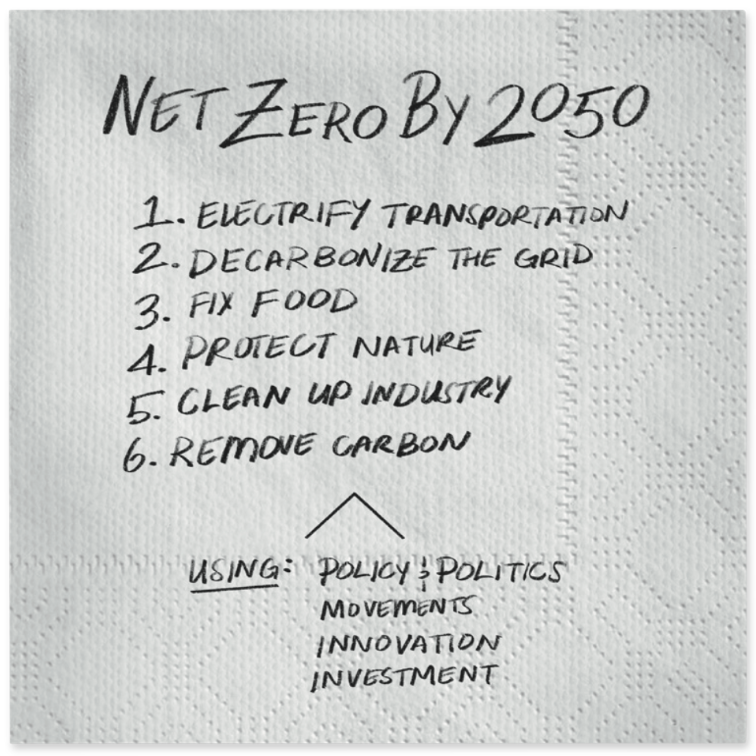Solving our climate crisis will require a transformation of the global economy. Virtually all emissions can be traced back to a corporation, whether public, private, or state-owned. Which means that companies have an outsize opportunity to lead the charge to net zero.
Our Speed & Scale Plan is grounded in a goal-setting system known as OKRs. You’ll find ten clear objectives–six solutions and four accelerants–with corresponding key results. As spelled out in Key Result 8.3, corporations must commit to zeroing out all greenhouse gas emissions by 2050 and take these five actions:
1. Set a clear net zero goal;
2. Measure and disclose all emissions;
3. Cut emissions;
4. Purchase high-quality carbon offsets;
5. Catalyze the engineered carbon removal industry.
1. Set a clear net zero goal
Making progress on emissions cuts begins with a clear and ambitious goal. Based on the United Nations’ net zero standard, a company’s target must:
1. Cover all greenhouse gases and all three scopes of emissions;
2. Commit to using carbon removal to negate emissions that cannot be cut;
3. Set a deadline no later than 2050, and ideally earlier for easier-to-abate sectors.
Clarity matters. Scope 3, which encompasses supply chains and product usage, accounts for most corporate greenhouse gas emissions. In general, greenhouse gases other than carbon dioxide account for up to half of these emissions. When companies omit Scope 3 or non-carbon gases from their commitments, they may neglect to address the bulk of their emissions.
As an example, this is what a great goal looks like:
“We are committing to net zero greenhouse gas emissions by 2050 across scopes 1, 2, and 3, and will remove our excess emissions through carbon removal.”
As a reminder, Scope 1 represents the emissions generated from internal operations. Scope 2 refers to the emissions from purchased energy. Scope 3 contains emissions from a company’s supply chains and product usage.
For corporations looking for best-in-class guidance and quality assurance, the United Nations has endorsed the Science Based Targets initiative’s net zero standard. Organizations can commit to a net zero goal through SBTi here and flesh out the details with the organization’s support over a two-year period.
2. Measure and disclose all emissions
As the saying goes, you can’t manage what you don’t measure. To cut greenhouse gas emissions effectively, corporations need to know how much they’re emitting and where those emissions originate. Emissions must be measured transparently. Platforms such as Watershed or Persefoni can help companies measure, disclose, and track their emissions over time.
Scopes 1 and 2 are essentially accounting exercises and relatively straightforward to measure. Measuring Scope 3 is more difficult. It will require working with your suppliers and understanding how your products are used. Absolute precision is less important than defining the magnitude and sources of those emissions.
Some countries already mandate public disclosure of corporate emissions. As more countries update their rules, corporations should partner with CDP (formerly the Carbon Disclosure Project), the gold standard in this arena for the past twenty years, and publish their responses online.
Disclosure has many benefits. Since one company’s emissions show up in others’ supply chains, greater transparency helps everyone. Transparency also enables informed consumers to reward corporations that are aggressively cutting emissions.
3. Cut emissions
To start, companies should tackle their largest sources of greenhouse gas emissions. The Speed & Scale action guide highlights these best first steps:
– Procure clean energy;
– Decarbonize the ways you move people and goods;
– Shrink the carbon footprint of the goods you manufacture.
Again, collaboration will be essential. Companies should work with their suppliers, industry groups, policymakers, and NGOs to solve tough problems and invest in new technology together. For example, when USPS rolls out electric delivery vehicles, it reduces logistics emissions (scope 3) for corporate clients that use them for shipping.
4. Buy high-quality carbon offsets
Offsets enable companies to pay to partially counterbalance their current emissions by helping other entities reduce their own emissions and also by protecting our planet’s natural carbon sinks.
Despite the fact that offsets are often plagued by quality control and transparency issues, they are critical for underwriting causes that require urgent investment. At an average cost of about ten dollars per ton, companies in some industries can offset their entire footprint today as they simultaneously cut their emissions. In the near future, corporations will be able to get public credit for their offsetting. The Voluntary Carbon Markets Integrity Initiative will certify companies that are both aggressively cutting emissions and purchasing sufficient offsets.
5. Catalyze the engineered carbon removal industry
Even after all practical measures are taken to cut emissions, a significant fraction of a company’s emissions may remain. As a global community, we’ll ultimately need to rely on gigaton-scale, engineered carbon removal to eliminate emissions we cannot cut. In the meantime, companies have an important role to play in jumpstarting the removals market.
Engineered carbon removal currently costs more than six hundred dollars per ton, which makes it prohibitive to address a company’s entire emissions footprint. For now, corporations should purchase small amounts of engineered carbon removal – say, 0.1 percent of their emissions – to help catalyze this young industry. If the five hundred largest companies in the U.S. were to make that commitment, it would amount to a total annual investment of about $8 billion. As the process becomes cheaper, that $8 billion will pay for progressively more removal. The long-term goal is to make the technology cost-effective and enable corporations to buy all the removals they will eventually need to reach net zero.
Corporate leadership on climate is vital
The world needs companies to establish audacious goals for cutting their greenhouse gas emissions. While corporate leadership on climate matters enormously in its own right, it’s also a proving ground for government action. The outcome of this effort will go a long way toward determining what kind of planet we’ll have for the balance of this century, and beyond.












